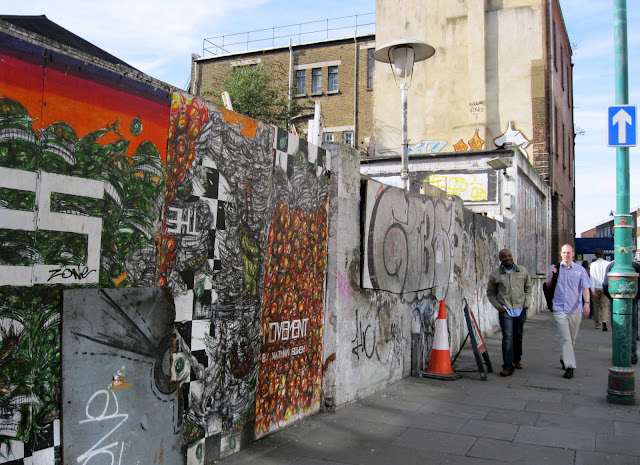During my History of London class this week we took a trip to Brick Lane. I had never been to this area before, but was suprised and pleased to find a culturally diverse area full of great art and delicious indian food. Throughout our walking tour, we stumbled across various areas and buildings decorated with graffiti. This particular area, pictured both above and below from different angles, shows a collaboration of graffiti from many different "artists". In my opinion, the graffiti on this street seems to diminish the beauty of the area. It makes the area look almost dirty and unkempt. I can appreciate areas that are completely encompassed by graffiti, but in this case the graffiti looks amateur and incomplete.
Pictured above is another example from our walk through Brick Lane. I do not like or appreciate the graffiti in this picture. The only sort of meaning that I can decipher from the signage is that it must be someone's name or a group they are involved in. I find this sort of graffiti to learn more towards vandalism because it does not display any sort of element of art. This graffiti just seems lazy and egotistical. I can appreciate graffiti that demonstrates the individual's true passion for art or graffiti that is created to express emotions and make statements, but the preceding picture does not seem to do any of these things.
The picture above was also taken in Brick Lane. The following graffiti, or street art, is located on a large wall that has various other marks of graffiti, but none as remarkable as the one pictured above. The following image was created by an artist who carved into a white wall to create the image of a man. I think this artwork definately enhances the area. It is located on a boring, old building and was able to transform this plain building into a work of art. It is clear that the artist who created this image is very talented and his work should be appreciated. One aspect of this image that I dislike, is the various graffiti on top of this beautiful creation. These other amatuer graffiti artists seem to be attempting to diminish the true beauty of the initial artwork, but have not been very successful judging by how striking the image continues to be.
Pictured above is another example from our walk through Brick Lane. I do not like or appreciate the graffiti in this picture. The only sort of meaning that I can decipher from the signage is that it must be someone's name or a group they are involved in. I find this sort of graffiti to learn more towards vandalism because it does not display any sort of element of art. This graffiti just seems lazy and egotistical. I can appreciate graffiti that demonstrates the individual's true passion for art or graffiti that is created to express emotions and make statements, but the preceding picture does not seem to do any of these things.
The picture above was also taken in Brick Lane. The following graffiti, or street art, is located on a large wall that has various other marks of graffiti, but none as remarkable as the one pictured above. The following image was created by an artist who carved into a white wall to create the image of a man. I think this artwork definately enhances the area. It is located on a boring, old building and was able to transform this plain building into a work of art. It is clear that the artist who created this image is very talented and his work should be appreciated. One aspect of this image that I dislike, is the various graffiti on top of this beautiful creation. These other amatuer graffiti artists seem to be attempting to diminish the true beauty of the initial artwork, but have not been very successful judging by how striking the image continues to be.
On my frecuent excursions over by the National Theatre, my eyes have been drawn to the skate park that is completely surrounded by graffiti. I find the graffiti in this area very intriguing and artistic. This skate park seems to be an area that allows and possibly even encourages graffiti due to the fact that it's in a very busy and well-known area. The graffiti seems to fit with the decor of the area. A skate park is generally an area for people to express themselves and go against the grain of society. I also appreciate how this skate park, with its extensive graffiti, is located directly next to the National Theatre, which is a very classy and popular venue.












